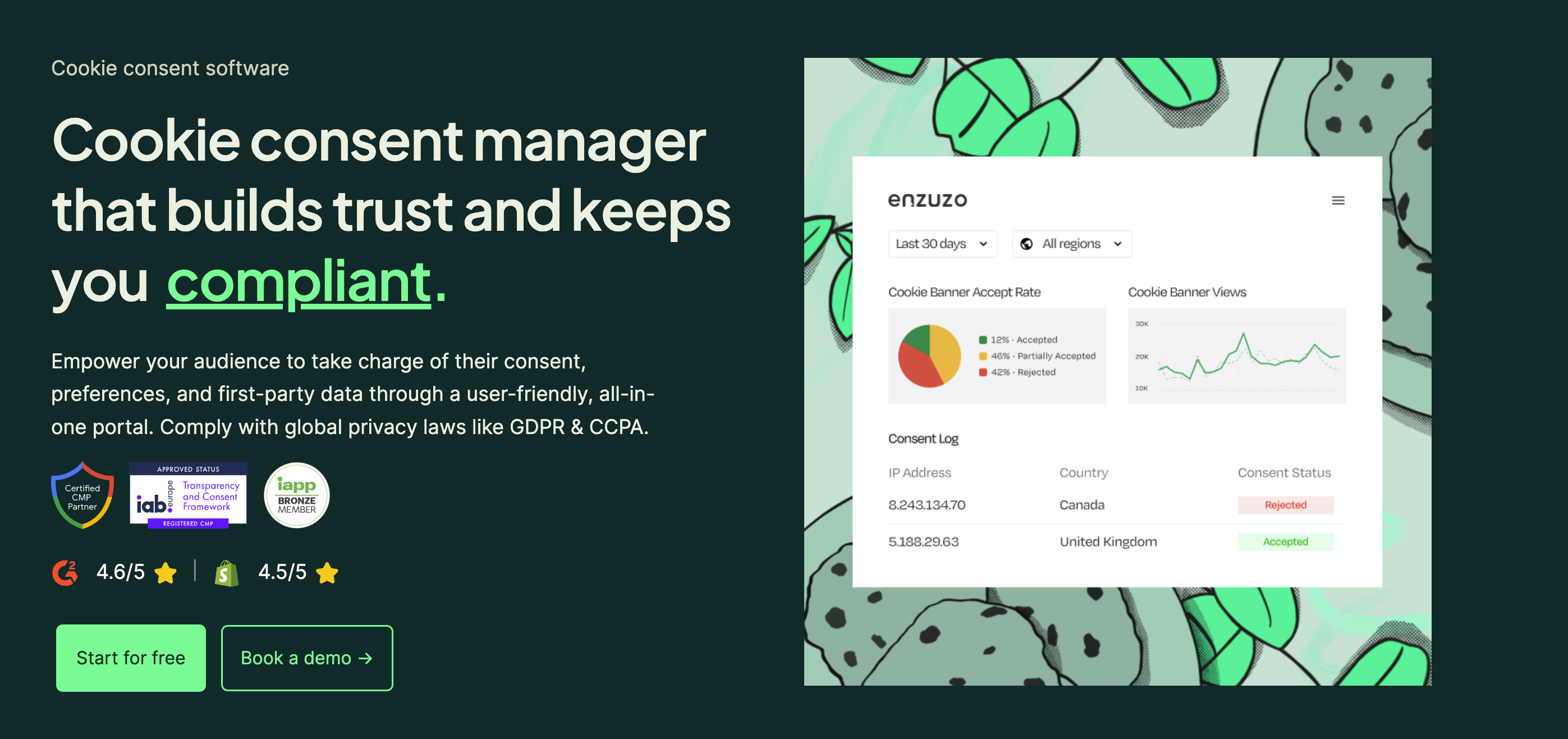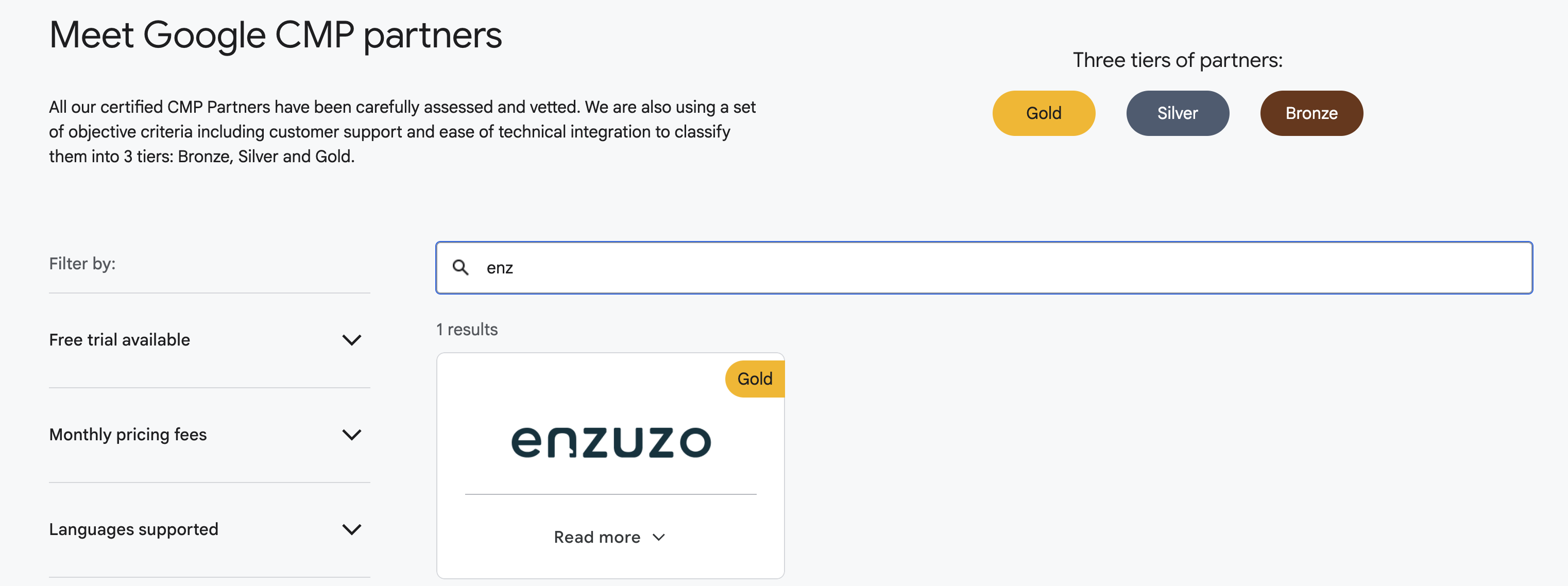The 11 Best Consent Management Platforms (Updated!)

Table of Contents
Best Consent Management Software
Consent management is a core principle in data privacy and compliance. It grants individuals the right to oversee how their personal information is collected, used, and shared by organizations.
This concept first came to the forefront with the General Data Protection Regulation (GDPR), which mandated that organizations get explicit consent from website visitors to opt in or deny tracking cookies. Since then, other data privacy regulations have taken a similar stance, including Canada’s Quebec Law 25, and the United States’ California Consumer Privacy Act (CCPA).
It's fair to say that consent management is a hot button topic in 2024 with the rollout of Google Consent Mode as well as greater public oversight and scrutiny into data handling practices. In this post, we'll help you shortlist the right consent management platform to build user trust, keep you compliant, and remain on the right side of the law.
👉 How much does consent management cost? Read our guide.
What are Consent Management Platforms?
Consent management platforms (CMPs) are software applications that track and record user consent preferences, helping websites comply with data privacy regulations and stay on the right side of the law.
CMPs securely track and store consent preferences, dictating which data is stored and shared as well as helping maximize opt-ins with a well-designed cookie banner. The best CMPs manage the entire personal data lifecycle — from the initial frontend consent notices all the way to data deletion requests. This lets you display compliance for data subject rights and access requests, giving regulators a clear audit trail on individual consent preferences.
👉 Interested in building a consent manager? Start for free (no credit card required)
Features of the Best Consent Management Platforms
A good consent management platform can:
-
Perform pre-scheduled website scans to discover and categorize cookies.
-
Display geo-specific consent notices and consent banners.
-
Collect and store consent based on categories (e.g., strictly necessary, analytics, targeting, etc.)
-
Maintain audit logs to record and track cookie banner settings and preferences modifications.
-
Build dashboards for your executive team to monitor and track consent status.
- Display data with an accessible, easy-to-navigate user interface.

Screenshot of Enzuzo's Consent Manager Interface
The features listed above are the foundations of professional user consent management software, but choosing the right tool for your business is a decision that's multifaceted in nature.
Features come into play when there's a balance between pricing, integrations, customization, scalability, and the integrity of the software. Not all websites are created equal — integrating consent banners for complex websites featuring ten of thousands of pages with multiple subdomains is a different affair compared to those that live on a one-page static site.
As websites grow in complexity, so do consent and opt-in requirements: administrators would likely want multi-domain management and advice on opt-in optimization and consent best practices. Visitors from different geographies will need a different cookie banner. And consent preferences may need to be exported into new domains.
Each consent manager reviewed here suits a different section of the market: some are best for large enterprises with larger budgets, while others perform well on smaller sites. Our list also takes into consideration online reviews and what real users have said about each tool.
The Top Consent Management Platforms
The list below narrows down your options to 11 different consent management platforms. Each has slightly different service offering and pricing options — we've included their best features, points to consider while you evaluate your options, pricing, and whether a free trial is included.
1. Enzuzo (Best All-Round Solution)

Enzuzo's global consent management solution is ideal for mid-market companies and up; those looking for a robust and feature-rich solution that won't break the bank. Enzuzo helps businesses adhere to crucial industry regulations across GDPR, CCPA, and Quebec Law 25. It can also provide support for other compliance frameworks, such as Brazil’s General Data Protection Law (LGPD) and South Africa's POPIA
Most importantly, Enzuzo is a Google CMP-certified vendor, which gives clients the assurance that it makes them compliant with Google consent mode.
Its latest update introduces a world-class cookie consent management tool that can be activated for selective, geo-targeted consent notices shown to visitors from specific regions and countries. Let's explore further why Enzuzo is our #1 pick:
Enterprise Consent Management Features

Enzuzo's consent manager unlocks organizations to:
-
Integrate cookie banners with your tag manager and content management system.
-
Establish a historical consent database to showcase compliance to regulatory bodies and auditors.
-
Exhibit geo-specific cookie consent banners.
-
Perform comprehensive website scans to uncover existing cookies.
-
Conduct tests on a staging site before pushing live.
-
Store cookie banner consent across multiple domains.
- Build a consent program via its API
- Display advanced analytics, opt-in statistics, and more.
-
Customize consent banners to align seamlessly with the company brand and visual identity.
It also offers pre-built cookie banner templates while allowing a range of customization with CSS options. Companies can add their fonts, colors, messaging, logos, and more.
👉 Read Why Global Conglomerate Lucy Group Picked Enzuzo As Its Data Privacy Partner [Case Study]
Brand New Analytics Capabilities

Enzuzo's new analytics feature helps marketers and business owners with several different things:
- Pageviews and Consent Behaviour Optimization: Learn how users interact with your consent banner, track trends and opt-in rates, and make tweaks for higher consent rates.
- Ironclad proof of compliance: The analytics tool goes beyond simple consent logs to demonstrate proof of compliance. The dashboard gives auditors an easy-to-digest summary of how the consent banner pops up in different jurisdictions and how users interact with it.
- Debugging Tools: Setting up and configuring consent banners can be complicated. Google Tag Manager can serve up unexpected behavior, leading to incorrect configuration. What's more, consent banner requirements vary by country and state and businesses that operate in multiple markets would have to use a VPN to simulate international users. Enzuzo's analytics tool gives you granular insights into banner behavior, helping you identify and rectify problems early.
- Privacy-compliant analytics: The consent banner is shown to unique website visitors, which means marketers can use the metrics reliably for funnel metrics. This also provides a useful hedge to tools like GA4, which are always at the risk of being banned in the EU due to non-compliant practices. Enzuzo's analytics tools only use IP addresses and user agents to model visitors, so it is privacy compliant on all levels.
Google-Certified Gold CMP Partner

Enzuzo is a premium Google CMP partner in the Gold category, highlighting its adherence to advanced consent management protocols, customer success, and number of integrations. What's more, Enzuzo is also compatible with Microsoft UET Consent Mode, helping you build a robust consent strategy across multiple platforms.
👉 Here's how to comply with Google Consent Mode using Enzuzo
Ideal Partner for Agencies & Multiple Domains
Enzuzo is a scalable solution for complex websites that have thousands of pages and subdomains and companies that manage multiple domains under one brand. The agency plan offers unlimited traffic, a whitelabel solution, and all the features you would expect from advanced enterprise software.
Agencies looking to onboard multiple clients and manage them inside a single dashboard will find lots of value in Enzuzo, too.
👉 Read Enzuzo's Case Study with Uroboro
User Experience
Enzuzo offers a swift setup and installation process, engineered for speed and simplicity. All standard compliance workflows and legal pages are embedded with just a few lines of Javascript. Built-in dashboards and DSAR status requests give you a 360 degree view of data compliance activities, including warnings and error reports.
Enzuzo's UX shines in many of its reviews:

Multilingual Display & Consent
Enzuzo's consent management systems allow for the display of cookie notices and preference management in 25 different languages. This builds trust and makes it easier to communicate your policies in a language that's familiar to a global audience. Moreover, each consent notice can be customized to match brand guidelines, including colours, fonts, etc.
👉 Start building a free consent manager (no credit card required)
Scalable Pricing
We've mentioned this before, but Enzuzo's pricing scales ideally for organizations with multiple license requirements, high traffic volumes, and multiple subdomains. What's more, all monthly traffic calculations are per unique visitor, and not a total sum, different from most other CMPs on the market. The pricing overall is extremely competitive, and scales very well regardless of website complexity and traffic numbers.
Want to know how much consent management would cost for your business? Skip the sales pitch and get an instant quote for your business👇
Customer Support & Onboarding
Consistent uptime is a valuable differentiating factor, particularly in sensitive industries like data privacy. Software environments can break unexpectedly, and the last thing your organization needs is a non-compliant consent management tool.
Enzuzo's world-class customer support is available across Pacific, Mountain, Central, and Eastern time zones. All Enterprise plans come with white-glove onboarding, a dedicated Slack channel, a customer success manager, and an SLA for sub-24-hour response times. Premium customer support is a core part of how easy it is to onboard Enzuzo or migrate away from another tool.

Lean and Agile Web Application
Apps shouldn't drag down website performance. If so, they hurt core web vitals and impact SEO rankings, conversion, and provide a frustrating user experience.
Enzuzo has worked 1-1 with multiple web design and SEO agencies to test its apps, strengthening its codebase to build a lightweight app that doesn't impact website load time.
Verdict

Enzuzo's consent management software offers many forward-thinking features, simplifying compliance with laws like GDPR, CCPA, Quebec Law 25, and more. What's more, it also offers seamless integrations across various web platforms, with native apps for Shopify and Webflow, and easy-to-implement install guides for Wix, Wordpress, and headless CMS environments.
If you're looking for the trifecta of robust features, competitive pricing, and seamless onboarding and integration, we recommend Enzuzo as your top choice.
Learn how Enzuzo can meet your consent management needs. Book a no-obligation, 1-1 strategy call with a product expert👇
2. OneTrust (Best for Enterprise Budgets)
OneTrust offers one of the most feature-rich CMP software apps in the market, including support for websites, mobile apps, connected TV environments, and OTT solutions. It's a comprehensive platform with a plethora of features that reflect its premium status.
However, this comes at a cost. OneTrust is by far the most expensive solution on this list — pricing isn't even disclosed on the website with each package tailormade for individual requirements.

We've been informed that OneTrust contract sizes can start at north of $50,000, renewed yearly. These include consent management features as well as other data privacy must-haves such as data governance, data mapping, and privacy impact assessments.
OneTrust is a complex software application — this has its sets of drawbacks, too. It's hard to integrate with in-house systems and there are no native applications for Shopify, Wordpress, or Webflow. What's more, customer support can be evasive and hard to get a hold of.
Overall, OneTrust is an excellent choice for large corporations with gargantuan compliance and privacy budgets. Expect long-term contracts and high onboarding costs, but a feature-rich solution that's the gold standard of consent management platforms.
Verdict
OneTrust is a versatile privacy management platform best suited for larger enterprises and industries subject to stringent regulations. Its extensive feature set makes it a robust choice for such organizations. However, its considerable cost and complexity might render it less suitable in this challenging economic environment.
3. CookieYes
CookieYes is a simple, no-frills platform that does the job. It offers friendly UX and responsive customer support alongside the major consent management features, including automatic website scans, custom branding, and geo-targeted cookie consent.
All of its plans feature a free trial period, so companies can test the services before they commit.

There are three pricing tiers: Basic, priced at USD 10/month, Pro at USD 20/month, and Ultimate at USD 40/month. The price is per domain, which undoubtedly escalates if you're looking for support for multiple domains inside one dashboard The company offers numerous integration options, though there have been reports of compatibility issues.
The downside is that CookieYes restricts website traffic and page scans on most plans, which may cause some customers to look elsewhere. Some reviews on G2 suggest that multi-license plans with unlimited pageviews can run into the several hundred dollars a month range, which is too pricey for a simple plug-and-play tool.
Verdict
CookieYes doesn’t attempt to compete with enterprise-level compliance solutions. It's a simple, straightforward tool that's suited for startups, small businesses, and blogs. Since it's focused exclusively on cookie consent management, it does not offer additional features like DSAR automation, legal policies, or end user license agreements.
4. Ketch
US-based Ketch covers a comprehensive list of privacy-focused tools, including consent management, data mapping, risk assessments, and more.
The Ketch Trust by Design platform offers pre-built templates for compliance with the GDPR and CCPA/CPRA, among other regulations. It's also a solid choice for marketers looking to capture first party data, with its preference management features.

The drawbacks of Ketch is its cumbersome onboarding process, which results in a single domain being added to the platform at a time. This may constrict large enterprise customers that are looking to deploy cross-domain consent features across hundreds of websites.
Ketch paid plans start at USD 350/month which includes consent management. The Pro plans have additional privacy compliance features, but pricing isn't revealed and can only be accessed after a sales demo.
Verdict
Ketch has a great set of features. Enterprise users will find value in its AI-based approach to data privacy, enabling agile adaptation to rapidly changing privacy regulations.
With that in mind, Ketch is particularly suitable for larger enterprises. While Ketch does offer a free version that small businesses can utilize, these basic functionalities may take them only so far.
Ketch is a good fit for companies with advanced requirements and privacy budgets to match.
5. Osano
Osano includes cookie consent features in its Pro plan, priced at $199/month. However, this plan caps out at two users, three domains, and 30,000 monthly website visitors which may not be enough for most businesses.

In terms of its consent management features, Osano offers a full-fledged product that's akin to Enzuzo but falls short of the bells and whistles in OneTrust. Privacy-conscious companies will like the plethora of additional features included in the advanced enterprise plans, including the 'No-Fines, No-Penalties' pledge but those come with a hefty price tag.
Osano does not offer customized legal policies in addition to the consent management product. Instead, it includes templatized agreements that companies can modify to their requirements. The absence of things like a privacy policy generator is irksome, when you're spending hundreds of dollars a month.
Overall, Osano's feature set is robust and competitive, but it comes with high costs and certain service limitations that may cause prospective buyers to think twice.
Verdict
Good product overall, but there's better value for money in the consent management market.
6. Didomi
Didomi is another established player, based in France. It offers many of the same mid-market features as others on this list and plenty of integrations.
From a features and product standpoint, Didomi delivers on all fronts. We also like that it emphasizes quality UX and compliance with major data privacy laws.

However, Didomi is known to be technical and difficult to set up. The consent management app can also significantly impact website load speeds, which hurts SEO and conversion.
Online reviews express concerns about the platform’s complexity, as well as the potential negative impact of Didomi on website performance.
Depending on the size and complexity of your website and the volume of traffic it receives, this issue may pose challenges that affect the overall user experience for your audience. Additionally, Didomi's pricing structure involves long contractual commitments, further limiting its suitability as an all-in-one platform. While Didomi remains a robust data tool, there are things to consider.
Verdict
One to consider if it fits your budget.
7. CookiePro

CookiePro is a tool by OneTrust, marketed as an affordable solution for smaller enterprises.
However, it's rapidly been increasing its prices and may not be a separate tool for much longer. In terms of its feature set, CookiePro offers:
- Cookie scanning
- Customizable cookie banners
- Cookie consent analytics and dashboards
Since it's backed by OneTrust, the product is definitely reliable. However, there are question marks over customer support and onboarding. It's also a pricey tool for larger, complicated sites.
Verdict
A handy option for those who want the expertise of OneTrust without opting for the full GRC package.
8. TrustArc
TrustArc is one of the oldest incumbents in the privacy and consent management space. This long and storied history helps the company earn a spot in the list, despite some outdated UX and features that haven't kept up with the rest of the competition.

TrustArc allows you to pick a menu of services from its privacy management platform, including consent notifications in 45 languages. It also offers a managed privacy service for clients that do not have any internal compliance capabilities.
Some drawbacks of TrustArc are unhelpful and unresponsive customer support. Pricing information isn't included on the website, so you must book a demo to learn more.
Verdict
TrustArc is a solid platform for and its suite of additional managed services provides a strong backbone for a company’s ongoing compliance goals.
On the flip side, users should expect to pay high costs for TrustArc, particularly once additional managed services are added in.
Some users have reported a less-than-ideal user experience (UX) and subpar customer support, which could concern certain business owners. This means that, despite TrustArc’s powerful feature set, users should know it’s not the easiest platform to deploy. The lack of transparency in pricing may give prospective buyers pause.
9. Cookie Information
Next on our list is Denmark-based Cookie Information.
True to its name, the company focuses exclusively on cookie consent management and does not offer any other advanced data privacy features. Nonetheless, it's also a Google-certified CMP albeit a no-frills solution with basic cookie banners and cookie policies.

Cookie Information's pricing starts at 15 Euro/month for a single domain. That includes 500 pages, with the company stating that customers are required to pay more for larger websites.
Verdict
Cookie Information gets the job done, but the pricing is surprisingly higher than what we would expect from a tool of this caliber. Nonetheless, it's a decent solution for small businesses that don't have any fancy requirements.
10. Termly
Termly is another tool that's been serving small and medium-sized businesses for a few years. It includes a consent management product, alongside other privacy features such as privacy policies, terms and conditions agreements, EULAs, and more.

The consent management features include the usual suspects — cookie auto-blocking, categorization, custom branding, and more. Termly includes a free plan for websites up to 10,000 visitors / month, while the starter plan is billed at $10/month/domain.
Verdict
Suited for small businesses, startups, and those looking for cookie cutter data privacy and consent management solutions.
11. Iubenda
Rounding up our list is Iubenda. The firm is also a veteran in data privacy and is akin to Termly in the sense that it's suited for privacy conscious businesses that aren't looking to spend a lot of money.

Iubenda's consent management tool supports GDPR, CCPA/CPRA, and a range of other data privacy legislation. Pricing starts at $6.99/month but the company is surprisingly cagey on what all each plan covers. Our guesstimate is that basic cookie consent is included in the cheapest plan, but you might have to pay more for the advanced features.
Verdict
Decent option but may struggle against some of the giants in the consent management space.
How should you choose the right consent management platform?
At a high level, the right consent management platform for your business should be able to offer you scalable options and pricing as you grow your business, an intuitive onboarding experience, top-notch customer support, support for Google Consent Mode, and integrations with other platforms and apps. This ensures that your chosen CMP adapts to your business operating environment without a hassle.
However, what really separates the wheat from the chaff are consent platforms that can cater to the legislative requirements of different privacy laws around the world. The GDPR, for example, requires that consent be set to 'opt-out' by default, meaning users must expressly grant permission for cookies otherwise they should be blocked by default.
The CCPA takes a more lenient view — cookies can be loaded by default and it is up to an individual user to opt-out. It's these subtle nuances that make all the difference. What's more, you would likely want your CMP to integrate with Google Tag Manager for better scalability and analytics.
New Google CMP Requirements for Consent Managers
Google is implementing wholesale changes to how businesses run ads, requiring that they comply with two options: implement new consent mode parameters directly inside Tag Manager or use a Google-certified consent management platform to use its ads platform. Advertisers who fail to follow these guidelines will be restricted from running ads in the EU and UK.
It's important to note that only a select few consent management platforms have met Google's requirements, since this involves various technical improvements and updates. We believe it is an important differentiating factor for competitors in the consent management industry.
Consent Management FAQs
Do I need a cookie consent manager?
If your website or mobile app collects personally identifiable information, then yes you need a consent manager set up. That's because you're likely getting website traffic from North America or Europe — which is where regulations like GDPR and CCPA kick in and your business could be fined for non-compliance.
How do I implement a consent manager?
Each consent manager works separately and has their own implementation information. For example, Enzuzo can be set up with a couple of lines of Javascript in your website's <head> tag. It also offers easy integration with Google Tag Manager.
How does consent management work?
Consent managers work by acting as an intermediary between website managers and their users. These third-party applications ask users if they grant the website or mobile app permission to identify them for marketing, advertising, and analytics purposes. This assists in tracking conversions and understanding the actions that the user took on the site. Some websites also share this information with their partners. The entire function of consent managers is to manage this relationship and relay back to the website whether a user has granted them permission for this tracking or not.
What are the major consent management laws?
The earliest and most significant consent management legislation was the EU’s General Data Protection Regulation (GDPR).
Under the GDPR is the ePrivacy Directive, also an EU standard. This directive lays down the law for businesses by giving them an exact framework of what they can and cannot do. For example:
In Article 12 of the GDPR, Businesses must clearly define what data is being collected, why it’s being collected, and how consumers can contact your business to access, amend, or request that you delete it.
And Article 18 of the GDPR states that consumers have the right to refuse to allow cookies that would track them or to restrict a data transfer to third parties for further processing. This explicitly allows them to “opt out” if they wish. Moreover, businesses cannot restrict website access just because a user opts out of the tracking request.
Next, the California Consumer Privacy Act (CCPA) covers the use of PII extensively except financial and healthcare sectors with their own legislation.
Under the CCPA, websites must inform visitors what data will be collected by its cookies and trackers and how that information will be used. The act also includes frameworks for managing the storage and use of PII records.
Virginia’s Consumer Data Protection Act (VCDPA), has the same consent requirements as the CCPA.
The local data privacy law in Brazil is known as the Lei Geral de Proteção de Dados (LGPD). While it doesn’t specifically discuss cookies, the LGPD does similarly treat PII as CCPA.
In Canada, the new Quebec Law 25 has imposed similar stringent consent management requirements. This makes it mandatory for businesses to explicitly collect and store user consent, or risk heavy fines if not compliant.
What does CMP cover?
Consent management platforms cover user consent and privacy legislation. They categorize cookies in relevant groups and sub categories.
Once all cookies are categorized, the CMP should create an appropriate consent popup notification allowing users to accept or deny cookies.
All responses must be stored and kept in valid log files for audit purposes. Advanced CMPs can also store consent across several websites all owned by the same entity.
Cookie consent systems must also block trackers if visitors do not give consent.
Looking to onboard a CMP? Book a complimentary 1-1 strategy call with a product expert👇

Osman Husain
Osman is the content lead at Enzuzo. He has a background in data privacy management via a two-year role at ExpressVPN and extensive freelance work with cybersecurity and blockchain companies. Osman also holds an MBA from the Toronto Metropolitan University.


